Indian leopard
The Indian leopard (Panthera pardus fusca) is a leopard subspecies widely distributed on the Indian subcontinent. The species Panthera pardus is listed as Vulnerable on the IUCN Red List because populations have declined following habitat loss and fragmentation, poaching for the illegal trade of skins and body parts, and persecution due to conflict situations.[1]
| Indian leopard | |
|---|---|
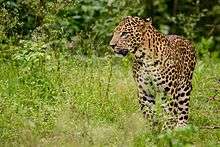 | |
| A male leopard in Nagarhole National Park | |
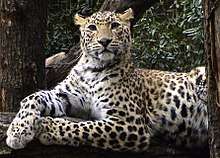 | |
| A female at Bardiya National Park | |
| Scientific classification | |
| Kingdom: | Animalia |
| Phylum: | Chordata |
| Class: | Mammalia |
| Order: | Carnivora |
| Suborder: | Feliformia |
| Family: | Felidae |
| Subfamily: | Pantherinae |
| Genus: | Panthera |
| Species: | |
| Subspecies: | P. p. fusca |
| Trinomial name | |
| Panthera pardus fusca (Meyer, 1794) | |
| Synonyms | |
The Indian leopard is one of the big cats occurring on the Indian subcontinent, apart from the Asiatic lion, Bengal tiger, snow leopard and clouded leopard.[2][3][4]
In 2014, a national census of leopards around tiger habitats was carried out in India except the northeast. 7,910 individuals were estimated in surveyed areas and a national total of 12,000-14,000 speculated.[5][6]
Taxonomy
Felis fusca was the scientific name proposed by Friedrich Albrecht Anton Meyer in 1794 who described a black leopard from Bengal that was on display at the Tower of London.[7] Leopardus perniger proposed by Brian Houghton Hodgson in 1863 were five leopard skins from Nepal, out of which three were black. He mentioned Sikkim and Nepal as habitat.[8] Panthera pardus millardi proposed by Reginald Innes Pocock in 1930 was a single leopard skin and skull from Kashmir. It differed from typical P. p. fusca skins by longer hair and more greyish colour.[9]
Since leopard populations in Nepal, Sikkim and Kashmir are not geographically isolated from leopard populations in the Indian subcontinent, they were subsumed to P. p. fusca in 1996.[10][11]
Characteristics
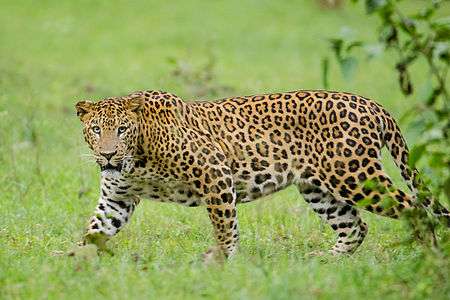
The Indian leopard has strong legs and a long well-formed tail, broad muzzle, short ears and small, yellowish grey eyes, light grey ocular bulbs.[7] Its coat is spotted and rosetted on a pale yellow to yellowish-brown or golden background, except for the melanistic forms; the spots fade toward the white underbelly and the insides and lower parts of the legs. Rosettes are most prominent on the back, flanks and hindquarters. The pattern of the rosettes is unique to each individual.[12][13] Juveniles have woolly fur, and appear dark due to the densely arranged spots. The white-tipped tail is 60–100 centimetres (24–39 in) long, white underneath, and displays rosettes, which form incomplete bands toward the end. The rosettes are larger in other leopard subspecies in Asia. Fur colour tends to be more pale and cream in arid habitats, more gray in colder climates, and of a darker golden hue in rainforest habitats.[2]
The clouded leopard can be told apart by its diffuse "clouds" of spots compared to the smaller and distinct rosettes of the leopard, longer legs and thinner tail.[14]
Skull
The largest skull recorded for an Indian leopard belonged to a large black panther in the area of Ootacamund, which was recorded in 1920. The panther was said to have bigger forelimbs and forequarters than hind-limbs and hind-quarters, and a skull and claws about as large as those of a tigress. The skull measured 11.2 in (28 cm) in basal length, and 7.9 in (20 cm) in breadth, and weighed 2 lb 4 oz (1,000 g). To compare, the skull of a West African panther measured 11.25 in (28.6 cm) in basal length, and 7.125 in (18.10 cm) in breadth, and weighed 1 lb 12 oz (790 g).[15]
Size
Male Indian leopards grow to between 127 cm (4 ft 2 in) and 142 cm (4 ft 8 in) in body size with a 76 cm (2 ft 6 in) to 91 cm (3 ft) long tail and weigh between 50 and 77 kg (110 and 170 lb). Females are smaller, growing to between 104 cm (3 ft 5 in) and 117 cm (3 ft 10 in) in body size with a 76 cm (2 ft 6 in) to 87.6 cm (2 ft 10.5 in) long tail, and weigh between 64 and 75 lb (29 and 34 kg). Sexually dimorphic, males are larger and heavier than females.[12]
The largest wild individual appears to have been a male man-eater that was shot in the Dhadhol area of Bilaspur district, Himachal Pradesh in 2016. It reportedly measured 262 cm (8 ft 7 in) from head to tail, 86 cm (34 in) at the shoulder, and weighed 71 kg (157 lb).[16][17]
Distribution and habitat

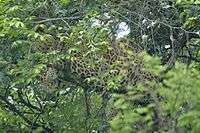
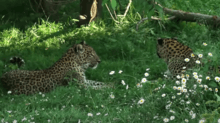
The Indian leopard is distributed in India, Nepal, Bhutan and parts of Pakistan.[1] Bangladesh has no viable leopard population but there are occasional sightings in the forests of Sylhet, Chittagong Hill Tracts and Cox's Bazar.[18][19] It inhabits tropical rainforests, dry deciduous forests, temperate forests and northern coniferous forests but does not occur in the mangrove forests of the Sundarbans.[2]
It is thought that the Indus River in the west and the Himalayas in the north form topographical barriers to the dispersal of this subspecies.[10] In the east, the Ganges Delta and the lower course of the Brahmaputra River are thought to form natural barriers to the range of the Indochinese leopard.[11]
In southern Tibet, it was recorded in Qomolangma National Nature Preserve.[20]
In Pakistan, it inhabits Himalayan forests and mountainous regions. In the 1970s, it was still recorded in the Kirthar Mountains, northeastern Baluchistan and Murree Hills.[21] Since the turn of the century, leopards were recorded in and around Machiara National Park, Pir Lasora National Park, and Ayubia National Park.[22][23] Leopards are occasionally spotted in the Margalla Hills in winter and are observed preying on monkeys in the woods as well as on local livestock.[24] In April 2020, photos of three leopard families were taken by camera traps in the Margalla Hills.[25]
In Nepal's Kanchenjunga Conservation Area, a melanistic leopard was photographed at an elevation of 4,300 m (14,100 ft) by a camera trap in May 2012.[26]
Population in India
In 2015, 7,910 leopards were estimated to live in and around tiger habitat in India; about 12,000 to 14,000 leopards were speculated to live in the entire country. The following table gives the major leopard populations in the Indian states.[5]
| State | Leopards (2015) |
|---|---|
| Andhra Pradesh | 343 |
| Bihar | 32 |
| Chhattisgarh | 846 |
| Goa | 71 |
| Jharkhand | 29 |
| Karnataka | 1,129 |
| Kerala | 472 |
| Madhya Pradesh | 1,817 |
| Maharashtra | 905 |
| Odisha | 345 |
| Tamil Nadu | 815 |
| Uttar Pradesh | 194 |
| Uttarakhand | 703 |
Ecology and behaviour
.jpg)
The leopard is elusive, solitary, and largely nocturnal. It is known for its ability in climbing, and has been observed resting on tree branches during the day, dragging its kills up trees and hanging them there, and descending from trees headfirst.[27] It is a powerful swimmer, although is not as disposed to swimming as the tiger. It is very agile, and can run at over 58 kilometres per hour (36 mph), leap over 6 m (20 ft) horizontally, and jump up to 3 m (9.8 ft) vertically.[28] It produces a number of vocalizations, including grunts, roars, growls, meows, and purrs.[29]
In Nepal's Bardia National Park, home ranges of male leopards comprised about 48 km2 (19 sq mi), and of females about 17 km2 (6.6 sq mi); female home ranges decreased to 5 to 7 km2 (1.9 to 2.7 sq mi) when they had young cubs.[30] In Gir National Park, the home range of a male radio-collared leopard was estimated at 28.15 km2 (10.87 sq mi). It killed prey once in 3.7 days.[31]
The leopard is a versatile, opportunistic hunter, and has a very broad diet.[2] It is able to take large prey due to its massive skull and powerful jaw muscles.[32][33] In Sariska Tiger Reserve, the dietary spectrum of the Indian leopard includes axis deer, sambar deer, nilgai, wild boar, common langur, Indian hare and peafowl.[34] In Periyar Tiger Reserve, primates make up a large proportion of its diet.[35]
Reproduction
Depending on the region, the leopard mates all year round. The estrous cycle lasts about 46 days and the female usually is in heat for 6–7 days.[36] Gestation lasts for 90 to 105 days.[37] Cubs are usually born in a litter of 2–4 cubs.[38] Mortality of cubs is estimated at 41–50% during the first year. Females give birth in a cave, crevice among boulders, hollow tree, or thicket to make a den. Cubs are born with closed eyes, which open four to nine days after birth.[39] The fur of the young tends to be longer and thicker than that of adults. Their pelage is also more gray in colour with less defined spots. Around three months of age, the young begin to follow the mother on hunts. At one year of age, leopard young can probably fend for themselves, but remain with the mother for 18–24 months. The average typical life span of a leopard is between 12 and 17 years.[40]
Sympatric carnivores
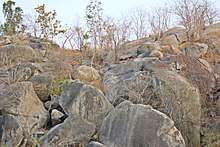
Indian leopards are not common in habitats where tiger density is high, and are wedged between prime tiger habitat on the one side, and cultivated village land on the other.[41] Where the tiger population is high or increasing, tigers drive leopards off to areas located closer to human settlements, like in Nepal's Bardia National Park and Sariska Tiger Reserve.[42][43]
In Gujarat's Gir National Park, the Indian leopard is sympatric with the Asiatic lion.[44] In the Himalayas, it co-occurs with the snow leopard up to an altitude of 5,200 m (17,100 ft).[11] They both hunt Himalayan tahr and musk deer, but the leopard usually prefers forested habitats located at lower altitudes than the snow leopard.[45]
Elsewhere on the Indian subcontinent, the Indian leopard is sympatric with the clouded leopard, jungle cat, leopard cat and fishing cat.[46][47][48] It also shares habitat with the golden jackal, Indian fox, striped hyena, dhole, Indian wolf, sloth bear and Asian black bear.[48][49][50]
Threats
Hunting of Indian leopards for the illegal wildlife trade is the biggest threat to their survival. They are also threatened by loss of habitat and fragmentation of formerly connected populations, and various levels of human–leopard conflict in human–dominated landscapes.[2]
Several newspapers reported of leopards falling into open wells and being rescued with the help of Forest Department officials.[51][52][53]
Poaching
A significant immediate threat to wild leopard populations is the illegal trade in poached skins and body parts between India, Nepal and China. The governments of these countries have failed to implement adequate enforcement response, and wildlife crime remained a low priority in terms of political commitment and investment for years. There are well-organised gangs of professional poachers, who move from place to place and set up camp in vulnerable areas. Skins are rough-cured in the field and handed over to dealers, who send them for further treatment to Indian tanning centres. Buyers choose the skins from dealers or tanneries and smuggle them through a complex interlinking network to markets outside India, mainly in China.[54] Seized skins in Kathmandu confirm the city's role as a key staging point for illegal skins smuggled from India bound for Tibet and China.[55]
It is likely that seizures represent a tiny fraction of the total illegal trade, with the majority of smuggled skins reaching their intended end market.[54] Seizures revealed:
- in India: more than 2845 poached leopards between 1994 and October 2010;[54][56][57][58][59][60]
- in Nepal: 243 poached leopards between May 2002 and May 2008;[54][55][61][62][63]
- in China and Tibet: more than 774 poached leopards between July 1999 and September 2005.[54][55]
In May 2010, the Wildlife Protection Society of India estimated that in India at least 3,189 leopards were killed since 1994. For every tiger skin, there are at least seven leopard skins in the haul.[64] Poaching for the illegal trade is suspected to have happened at a rate of at least four leopards per week during a 10-year period between 2002 and 2012.[65]
Human–leopard conflict
Expansion of agriculturally used land, encroachment by humans and their livestock into protected areas are main factors contributing to habitat loss and decrease of wild prey. As a result, leopards approach human settlements, where they are tempted to prey on dogs, pigs and goats — domestic livestock, which constitutes an important part of their diet, if they live on the periphery of human habitations. Human–leopard conflict situations ensue, and have increased in recent years. In retaliation for attacks on livestock, leopards are shot, poisoned and trapped in snares. The leopards are considered to be unwanted trespassers by villagers. Conservationists criticize these actions, claiming that people are encroaching on the leopard's native habitat.[66][67] India's Forest Department is entitled to set up traps only in cases of a leopard having attacked humans. If only the presence of a crowd of people prevents the leopard from escaping, then the crowd has to be dispersed and the animal allowed to escape.[68]
As urban areas expanded, the natural habitats of leopards shrunk resulting in leopards venturing into urbanized areas due to easy access of domestic food sources.[69] Karnataka has a high number of such conflicts.[70][71] In recent years, leopards were sighted in Bangalore, and the forest department captured six leopards in the city's outskirts, relocated four of them to various other locations.[72]
In and around the Shivalik hills of Himachal Pradesh, 68 leopards were killed by people between 2001 and 2013, of which 10 had been declared man-eaters.[73]
Man-eating
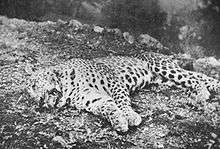
The frequency of Leopard attacks on humans varies by geographical region and historical period. Attacks are regularly reported only in India and Nepal.[74][75] Among the five "big cats", leopards are less likely to become man-eaters—only jaguars and snow leopards have a less fearsome reputation.[76][77] While leopards generally avoid humans, they tolerate proximity to humans better than lions and tigers and often come into conflict with humans when raiding livestock.[78]
Leopard attacks may have peaked in India during the late 19th and early 20th centuries, coinciding with rapid urbanization.[76] Attacks in India are still relatively common, and in some regions of the country leopards kill more humans than all other large carnivores combined.[79][80]
In Nepal, the rate of leopard predation on humans is estimated to be 16 times higher than anywhere else, resulting in approximately 1.9 human deaths annually per million inhabitants. Most attacks occur in the midland regions, i.e. in the Terai, midhills, and lesser Himalaya.[75]
It is possible for humans to win a fight with a leopard, as in the case of a 56-year-old woman who killed an attacking leopard with a sickle and spade, and survived with heavy injuries.[81] Globally, attacks on humans—especially nonfatal attacks that result in only minor injury—likely remain under-reported due to the lack of monitoring programs and standardized reporting protocol.[82] Notable man-eaters include Leopard of Panar, Leopard of the Central Provinces, Leopard of Rudraprayag, Leopard of Gummalapur, Leopard of the Yellagiri Hills and Leopard of the Golis Range.[83]
Conservation

Panthera pardus is listed in CITES Appendix I.[1] Despite India and Nepal being contracting parties to CITES, national legislation of both countries does not incorporate and address the spirit and concerns of CITES. Trained human resources, basic facilities and effective networks for control of poaching and trade in wildlife are lacking.[61]
Frederick Walter Champion was one of the first in India who after World War I advocated for the conservation of leopards, condemned sport hunting and recognised their key role in the ecosystem.[84] Billy Arjan Singh championed their cause since the early 1970s.[85]
There a few leopard rescue centres in India, such as the Manikdoh Leopard Rescue Centre in Junnar,[86] but more rescue and rehabilitation centres are being planned.[87] Some wildlife experts think that such centres are not an ideal solution, but that conflict resolution by way of changing human behaviour, land use or grazing patterns and implementing responsible forest management to lessen human-animal conflict would be far more effective to conserve leopards.[88]
In culture and literature
.jpg)

- An Indian black panther named 'Bagheera' is featured in Rudyard Kipling's 1894 novel The Jungle Book, as well as in Disney's 1967 and 2016 film adaptations.[89]
- The book Man-Eaters of Kumaon is based on man-eating leopards and tigers in Kumaon.[90]
- Ajoba is a 2014 Marathi film directed by Sujay Dahake and written by Gauri Bapat. It is supposedly based on true events.[91] Big Cats, Big Adventure. Malshej Ghat to Mumbai in 29 days: Ajoba the leopard's ambitious trek.
- Local people in the Western Ghats call a darkish grey panther 'Pogeyan', meaning "the cat that comes and goes like the mist."[92][93]
See also
Leopard subspecies: African leopard · Arabian leopard · Anatolian leopard · Persian leopard · Indochinese leopard · Javan leopard · Sri Lankan leopard · Amur leopard · Panthera pardus spelaea · Chinese leopard · Zanzibar leopard
References
- Stein, A.B.; Athreya, V.; Gerngross, P.; Balme, G.; Henschel, P.; Karanth, U.; Miquelle, D.; Rostro, S.; Kamler, J.F. & Laguardia, A. (2016). "Panthera pardus". IUCN Red List of Threatened Species. 2016: e.T15954A102421779.
- Nowell, K.; Jackson, P. (1996). "Leopard Panthera pardus (Linnaeus, 1758)". Wild Cats: status survey and conservation action plan. Gland, Switzerland: IUCN/SSC Cat Specialist Group. pp. 24–30. Archived from the original on 22 February 2014.
- Singh, H. S.; Gibson, L. (2011). "A conservation success story in the otherwise dire megafauna extinction crisis: The Asiatic lion (Panthera leo persica) of Gir forest" (PDF). Biological Conservation. 144 (5): 1753–1757. doi:10.1016/j.biocon.2011.02.009.
- Pandit, M. W.; Shivaji, S.; Singh, L. (2007). You Deserve, We Conserve: A Biotechnological Approach to Wildlife Conservation. New Delhi: I. K. International Publishing House Pvt. Ltd. ISBN 9788189866242.
- Bhattacharya, A. (2015). "Finally, India gets a count of its leopard numbers: 12,000-14,000". Times of India. Retrieved 20 February 2016.
- Mazoomdaar, J. (2015). First ever leopard census: India should not feel too smug too soon. The Indian Express, 7 September 2015.
- Meyer, F. A. A. (1794). "Über de la Metheries schwarzen Panther". Zoologische Annalen. Erster Band. Weimar: Im Verlage des Industrie-Comptoirs. pp. 394–396.
- Hodgson, B. H. (1863). "Leopardus perniger, Hodgson". Catalogue of the Specimens and Drawings of Mammalia, Birds, Reptiles and Fishes of Nepal and Tibet. London: British Museum.
- Pocock, R. I. (1930). "The Panthers and Ounces of Asia". Journal of the Bombay Natural History Society. 34 (2): 307–336.
- Miththapala, S.; Seidensticker, J.; O'Brien, S. J. (1996). "Phylogeographic Subspecies Recognition in Leopards (Panthera pardus): Molecular Genetic Variation". Conservation Biology. 10 (4): 1115–1132. doi:10.1046/j.1523-1739.1996.10041115.x.
- Uphyrkina, O.; Johnson, E.W.; Quigley, H.; Miquelle, D.; Marker, L.; Bush, M. & O'Brien, S. J. (2001). "Phylogenetics, genome diversity and origin of modern leopard, Panthera pardus" (PDF). Molecular Ecology. 10 (11): 2617–2633. doi:10.1046/j.0962-1083.2001.01350.x. PMID 11883877.
- Pocock, R. I. (1939). "Panthera pardus". The fauna of British India, including Ceylon and Burma. Mammalia. 1. London: Taylor and Francis. pp. 222–239.
- Menon, V. (2014). Indian Mammals: A Field Guide. Gurgaon, India: Hachette India. ISBN 978-93-5009-761-8.
- Francis, C.M. (2008). A Field Guide to the Mammals of Southeast Asia. London, UK: New Holland. p. 296. ISBN 978-1-84537-735-9.
- Prater, S. H. (1921). "Record Panther Skull (P. p. pardus)". The Journal of the Bombay Natural History Society. XXVII (IV): 933–935.
- Times of India (2016). "Is this the longest leopard in India?". Bennett, Coleman & Co. Ltd.
- The Tribune (2016). "Leopard shot in Bilaspur turns out to be a record breaker". The Tribune Trust.
- Khan, M. A. R. (2009). "Endangered mammals of Bangladesh". Oryx. 18 (3): 152–156. doi:10.1017/S0030605300019001.
- Kabir, M.T.; Ahsan, M.F.; Khatoon, A. (2017). "Occurrence and conservation of the Indian Leopard (Mammalia: Carnivora: Felidae: Panthera pardus) in Cox's Bazar District of Bangladesh". Journal of Threatened Taxa. 9 (6): 10320–10324. doi:10.11609/jott.1898.9.6.10320-10324.
- Laguardia, A.; Kamler, J. F.; Li, S.; Zhang, C.; Zhou, Z. & Shi, K. (2017). "The current distribution and status of leopards Panthera pardus in China". Oryx. 51 (1): 153−159. doi:10.1017/S0030605315000988.
- Roberts, T. J. (1977). "Panthera pardus". The Mammals of Pakistan. London: Ernest Benn. pp. 153–155. ISBN 0510399002.
- Kabir, M.; Awan, M. S.; Anwar, M. (2013). "Distribution range and population status of common leopard (Panthera pardus) in and around Machiara National Park, Azad Jammu and Kashmir". Conservation Science. 4 (1): 107–118.
- Shehzad, W.; Nawaz, M. A.; Pompanon, F.; Coissac, E.; Riaz, T.; Shah, S. A. & Taberlet, P. (2015). "Forest without prey: livestock sustain a leopard Panthera pardus population in Pakistan". Oryx. 49 (2): 248–253. doi:10.1017/S0030605313001026.
- Azeem, M. (2015). "Leopards seen on Margalla Hills". Dawn. Retrieved 27 April 2019.
- Shahid, J. (2020). "Three families of common leopard live in Margalla Hills". Dawn. Retrieved 5 May 2020.
- Thapa, K.; Pradhan, N. M. B.; Berker, J.; Dhakal, M.; Bhandari, A. R.; Gurung, G. S.; Rai, D. P.; Thapa, G. J.; Shrestha, S. & Singh, G. R. (2013). "High elevation record of a leopard cat in the Kangchenjunga Conservation Area, Nepal". Cat News (58): 26–27.
- Jerdon, T.C. (1874). Mammals of India: a natural history of the animals known to inhabit continental India. John Wheldon, London.
- "Animal bytes – Panthera pardus". Sea World. Archived from the original on 24 June 2008. Retrieved 6 June 2008.
- Estes, R. (1991). The Behavior Guide to African Mammals, Including Hoofed Mammals, Carnivores, Primates. Los Angeles: The University of California Press. ISBN 978-0520080850.
- Odden, M.; Wegge, P. (2005). "Spacing and activity patterns of leopards Panthera pardus in the Royal Bardia National Park, Nepal" (PDF). Wildlife Biology. 11 (2): 145–152. doi:10.2981/0909-6396(2005)11[145:SAAPOL]2.0.CO;2. Archived from the original (PDF) on 28 July 2011. Retrieved 24 February 2011.
- Zehra, N.; Chaudhary, R.; Khan, J. A. "Ecology of Leopard (Panthera pardus fusca Meyer) in Dry Tropical Forests of Gir National Park and Sanctuary, Gujarat, India". International Journal of Ecology and Environmental Sciences. 45 (3): 241–255.
- Burnie, D; Wilson, D. E. (2001). Animal: The Definitive Visual Guide to the World's Wildlife'. DK Adult. ISBN 978-0789477644.
- Boitani, L. (1984). Simon & Schuster's Guide to Mammals. Simon & Schuster/Touchstone Books. ISBN 978-0-671-42805-1.
- Mondal, K.; Gupta, S.; Bhattacharjee, S.; Qureshi, Q. & K. Sankar (2012). "Prey selection, food habits and dietary overlap between leopard Panthera pardus (Mammalia: Carnivora) and re-introduced tiger Panthera tigris (Mammalia: Carnivora) in a semi-arid forest of Sariska Tiger Reserve, Western India". Italian Journal of Zoology. 79 (4): 607–616. doi:10.1080/11250003.2012.687402.
- Srivastava, K. K.; Bhardwaj, A. K.; Abraham, C. J.; Zacharias, V. J. (1996). "Food habits of mammalian predators in Periyar Tiger Reserve, South India". The Indian Forester. 122 (10): 877–883. Retrieved 22 March 2013.
- Sadleir, R. (1966). "Notes on the Reproduction of the larger Felidae". International Zoo Yearbook. 6: 184–87. doi:10.1111/j.1748-1090.1966.tb01746.x.
- Hemmer, H. (1976). "Gestation period and postnatal development in felids". In R.L. Eaton (ed.). The World's Cats. 3. Carnivore Research Institute. pp. 143–165.
- Eaton, R.L. (1977). "Reproductive biology of the leopard". Zoologischer Garten. 47 (5): 329–351.
- Sunquist, M. E.; Sunquist, F. (2002). Wild Cats of the World. Chicago: University of Chicago Press. p. 325. ISBN 978-0-226-77999-7.
- "Leopard (Panthera pardus); Physical characteristics and distribution". Comparative Mammalian Brain Collections.
- McDougal, C. (1988). "Leopard and Tiger Interactions at Royal Chitwan National Park, Nepal". Journal of the Bombay Natural History Society. 85: 609–610.
- Odden, M.; Wegge, P.; Fredriksen, T. (2010). "Do tigers displace leopards? If so, why?". Ecological Research. 25 (4): 875–881. doi:10.1007/s11284-010-0723-1.
- Rajvi, A. S. (2016). Tigress kills leopard at Sariska Reserve in India (Motion picture). Barcroft TV. Retrieved 8 April 2019.
- Singh, M.; Raval, P. P.; Dharaiya, N.; Soni, V. C. (1999). "Feeding niche of Asiatic Lion (Panthera leo persica) and Leopard (Panthera pardus) in the Gir Protected Area". Tigerpaper. 26 (2): 12–15.
- Lovari, S.; Minder, I.; Ferretti, F.; Mucci, N.; Randi, E.; Pellizzi, B. (2013). "Common and snow leopards share prey, but not habitats: competition avoidance by large predators?". Journal of Zoology. 291 (2): 127–135. doi:10.1111/jzo.12053.
- Appel, A.; Ghimirey, Y.; Acharya, R. (2012). Status assessment of wild felids with a special focus on clouded leopard and Asian golden cat in the Hugu-Kori forest, Annapurna Conservation Area, Nepal. Report submitted to Point Defiance Zoo and Aquarium and Wuppertal Zoo Association. Kathmandu: Friends of Nature.
- Borah, J.; Sharma, T.; Das, D.; Rabha, N.; Kakati, N.; Basumatary, A.; Ahmed, M. F.; Vattakaven, J. (2013). "Abundance and density estimates for common leopard Panthera pardus and clouded leopard Neofelis nebulosa in Manas National Park, Assam, India". Oryx. 48: 149–155. doi:10.1017/S0030605312000373.
- Gurung, K. K. (1983). Heart of the Jungle. London: André Deutsch.
- Nabi, D. G.; Tak, S. R.; Kangoo, K.A.; Halwai, M. A. (2009). "Increasing incidence of injuries and fatalities inflicted by wild animals in Kashmir". Injury. 40 (1): 87–89. doi:10.1016/j.injury.2008.06.042. PMID 19131062.
- Karanth, K. K.; Nichols, J. D.; Hines, J. E.; Karanth, K. U.; Christensen, N. L. (2009). "Patterns and determinants of mammal species occurrence in India". Journal of Applied Ecology. doi:10.1111/j.1365-2664.2009.01710.x.
- "Watch Villagers Save Drowning Leopard in Dramatic Rescue". 4 August 2016. Retrieved 12 August 2018.
- "Leopard rescued from well in eastern India". USA TODAY. Retrieved 12 August 2018.
- "Leopard rescued from well, released". The Hindu. 11 August 2018. ISSN 0971-751X. Retrieved 12 August 2018.
- Banks, D., Lawson, S., Wright, B. (eds.) (2006). Skinning the Cat: Crime and Politics of the Big Cat Skin Trade. Environmental Investigation Agency, Wildlife Protection Society of India
- Banks, D. (2004). The Tiger Skin Trail. Environmental Investigation Agency.
- Wildlife Trust of India (2008). Leopard skin traders arrested in UP; eight skins recovered. Wildlife Trust of India, 29 July.
- Ghosh, A. (2008). 27 leopard skins seized in 45 days. Wildlife Protection Society of India.
- The Hindu (2008). Leopard skin, other wildlife products seized; five held.
- Wildlife Protection Society of India (2009). Leopard Skins Seized in Dehradun, 18 March 2009.
- The Indian Express Limited (2010). 4 with leopard hide held, role of politician to be probed, 12 October 2010.
- Aryal, R. S. (2009). CITES : Implementation in Nepal and India, Law, Policy and Practice (PDF) (2nd ed.). Kathmandu: Bhrikuti Academic Publications. ISBN 978-99933-673-3-8.
- Yonzon, P. (2008). Conservation of Tigers in Nepal 2007. Wildlife Conservation Nepal
- Wildlife Trust of India (2008). Cross-border wildlife traders arrested in Nepal with WTI’s help. Wildlife Trust of India, 12 May.
- Wildlife Protection Society of India (2010). Leopards Battling For Survival In India. Wildlife Protection Society of India, 18 May 2010.
- "Four Leopards a week enter India's illegal wildlife trade". Retrieved 12 August 2018.
- Sears, S. (2008). "Mumbai Leopards: Killers or Victims?" Archived 16 July 2011 at the Wayback Machine Wildlife Extra, 11 April 2008.
- Sears, S. (2009). "The wild leopards of Oman and Nepal – And how to see them" Archived 17 October 2011 at the Wayback Machine. Wildlife Extra, April 2009.
- Athreya, V., Belsare, A. (2007). Human – Leopard Conflict Management Guidelines. Kaati Trust, Pune, India.
- Dollar, L. (2016). "Leopards of India's Silicon City". National Geographic (blogs). Retrieved 7 February 2016.
- "Almost half of Karnataka 'lives' with leopards". The Hindu. 2015. ISSN 0971-751X. Retrieved 15 February 2016.
- "Nature Conservation Foundation - The secret lives of leopards". ncf-india.org. Retrieved 15 February 2016.
- "Leopard Spotted Inside Bengaluru School". The New Indian Express. Retrieved 7 February 2016.
- Kumar, P.; Chandel, S.; Kumar, V.; Sankhyan, V. (2017). "Leopard–Human Conflict Led Casualties and Conservation Awareness Campaign in Shivalik Hills of Northern India". Proceedings of the National Academy of Sciences, India Section B: Biological Sciences. 87 (3): 893−898. doi:10.1007/s40011-015-0653-3.
- Athreya, V. (2012). Conflict resolution and leopard conservation in a human dominated landscape (Ph.D.). Manipal University. Retrieved 29 March 2013.
- Maskey, T. M.; Bauer, J.; Cosgriff, K. (2001). Village children, leopards and conservation. Patterns of loss of human live through leopards (Panthera pardus) in Nepal (Report). Kathmandu, Nepal: Department of National Parks and Wildlife Conservation/Sustainable Tourism CRC.
|access-date=requires|url=(help) - Quigley, H.; Herrero, S. (2005). "Chapter 3: Characterization and prevention of attacks on humans". In Woodroffe, R.; Thirgood, S.; Rabinowitz, A. (eds.). People and wildlife: Conflict or co-existence?. Cambridge University Press. pp. 27–48. ISBN 9780521825054.
- Inskip, C.; Zimmermann, A. (2009). "Human-felid conflict: A review of patterns and priorities worldwide". Oryx. 43 (1): 18–34. doi:10.1017/S003060530899030X.
- Quammen, D. (2003). Monster of God: The Man-Eating Predator in the Jungles of History and the Mind. New York: W. W. Norton & Company. pp. 55–61. ISBN 9780393326093. Retrieved 20 March 2013.
- Kimothi, P. (2011). "Losers on both sides as man-animal war rages". The Pioneer. Archived from the original on 2 March 2011. Retrieved 22 March 2013.
- Athreya, V. R.; Thakur, S. S.; Chaudhuri, S.; Belsare, A. V. (2004). A study of the man-leopard conflict in the Junnar Forest Division, Pune District, Maharashtra (PDF) (Report). Submitted to the Office of the Chief Wildlife Warden, Maharashtra State Forest Department, and the Wildlife Protection Society of India, New Delhi, India.
- "Indian woman survives leopard attack after fighting predator for 30 minutes". The Telegraph. 27 August 2014. Retrieved 27 August 2014.
- Löe, J.; Röskaft, E. (2004). "Large carnivores and human safety: A review". AMBIO: A Journal of the Human Environment. 33 (6): 283–288. doi:10.1579/0044-7447-33.6.283. PMID 15387060.
- Corbett, E. J. (1954). The temple tiger and more man-eaters of Kumaon. London: Oxford University Press. pp. 64–86. OCLC 1862625. Retrieved 29 March 2013.
- Champion, F. W. (1934). "What is the Use of Leopards?". The Jungle in Sunlight and Shadow (Reprinted 1996 ed.). Dehra Dun: Natraj Publishers. pp. 71–80. ISBN 81-85019-53-3.
- Singh, A. (1982). Prince of Cats. London: Jonathan Cape. ISBN 978-0195654028.
- "Manikdoh Leopard rescue centre to get facelift". dna. 2013. Retrieved 12 August 2018.
- "Kanpur zoo to propose leopard rescue centre - Times of India". The Times of India. Retrieved 12 August 2018.
- "Protected parks or change in human behaviour: what will save the threatened leopards of Gujarat?". india.mongabay.com. 2018. Retrieved 12 August 2018.
- "Ben Kingsley to Voice Bagheera in Disney's The Jungle Book". Deadline. 25 June 2014. Archived from the original on 29 June 2014. Retrieved 25 June 2014.
- Man-Eaters of Kumaon (1944), Jim Corbett, Oxford University Press, Bombay.
- "Marathi film 'Ajoba' based on a leopard's fascinating journey, Urmila plays a wildlife biologist". 13 June 2013.
- Naish, D. (2009). "The Pogeyan, a new mystery cat". ScienceBlogs. Retrieved 19 January 2009.
- "BBC Wildlife Magazine". Vol. 27 no. 1–6. BBC. 2009. Retrieved 23 February 2017. Cite magazine requires
|magazine=(help)
Further reading
- Athreya, V.; Odden, M.; Linnell, J. D. C.; Krishnaswamy, J.; Karanth, U. (2013). "Big Cats in Our Backyards: Persistence of Large Carnivores in a Human Dominated Landscape in India". PLOS ONE. 8 (3): e57872. Bibcode:2013PLoSO...857872A. doi:10.1371/journal.pone.0057872. PMC 3590292. PMID 23483933.
- Biswas, R. (2020). The Indian Leopard - In the Realm of the Phantom. Tellwell Talent.
External links
| Wikimedia Commons has media related to Panthera pardus fusca. |
| Wikispecies has information related to Panthera pardus fusca |
- Species portrait Panthera pardus in Asia and short portrait P. pardus fusca; IUCN/SSC Cat Specialist Group
- wild-cat.org — Information about research and conservation of leopards in Asia
- Project Waghoba — Leopard Research and Conservation Project in Western Maharashtra, India
- Wildlife SOS: After 5 years, 3 leopards get a better life
- Mumbai’s Film City shut down after five leopard attacks